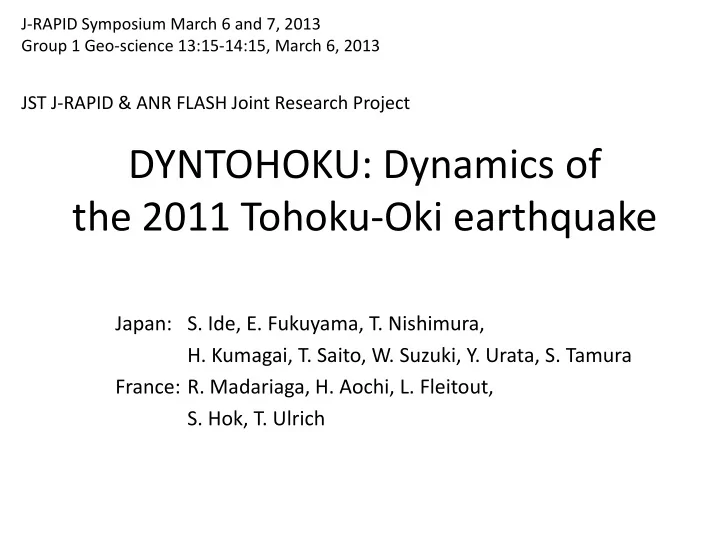

J-RAPID Symposium March 6 and 7, 2013 Group 1 Geo-science 13:15-14:15, March 6, 2013 JST J-RAPID & ANR FLASH Joint Research Project DYNTOHOKU: Dynamics of the 2011 Tohoku-Oki earthquake Japan: S. Ide, E. Fukuyama, T. Nishimura, H. Kumagai, T. Saito, W. Suzuki, Y. Urata, S. Tamura France: R. Madariaga, H. Aochi, L. Fleitout, S. Hok, T. Ulrich
Dynamics of the Tohoku-Oki EQ • Modeling the rupture process – Slip inversion using seismograms and GPS – Locating high-frequency sources • Fracture dynamics of shallow plate interface – Multiscale patch model to explain complex rupture – New simulation codes for realistic dynamics • Long-term deformation – Postseismic deformation and afterslip distribution – Viscoelasticity and far-field postseismic deformation
Inversion of static GPS displacement vectors Requires more than 50 m of slip on the fault over a zone of about 100x100 km black = obs white = model Inversion by GSI (T. Nishimura)
Non linear inversion of cGPS+ocean bottom GPS data 2 ellipses
Multi-scale Heterogeneity by Inversion Parameterisation by patch(es). Nonlinear inversion (GA) for 10 Ellipse -> Circle continuous GPS stations. 7 params -> t0, tr, x0, y0, r, vr, U km m (syn-obs) 2 /obs 2 Residual = N° iteration N° generation Synthetics (i th iteration) Observation Synthetic (final) Aligned at 14:46 JST Lowpass filter 20 sec. Thomas Ulrich & Hideo Aochi @ BRGM - DYNTOHOKU
Tsunami source of the 2011 Tohoku-Oki Earthquake Initial tsunami height distribution Coseismic Slip the high-water (> 2 m) region with large slip (~30 m) in deep part (~ 20 a width of ~ 100 km km) + large slip (~25 m) in shallow part ( < + the peak with a height more than 10 km ) 8 m locates near the trench Saito et al. 2011 GRL
Rupture processes of the mainshock and aftershocks Iwate-Oki aftershock (22 minutes later) M 0 =1.55×10 20 Nm (Mw7.4) • The large slip area seems to have ruptured • in the 1960 and 1989 earthquakes (Mw7.3) Iwate-Oki aftershock Ibaraki-Oki aftershock (29 minutes later) M 0 =9.90×10 20 Nm (Mw7.9) • Several M7-class earthquakes occurred • near the rupture area but there is no events whose large slip obviously occurred within the large slip of this event. Reverse-fault earthquakes occurred around the • large slip areas before (black) and after (purple) the Tohoku-Oki earthquake. The rupture progression processes of the two • aftershocks are relatively simple. Ibaraki-Oki aftershock Mainshock Aftershock for Iwate-Oki for Ibaraki-Oki Rupture progression of the Iwate-Oki event
High-frequency source radiation during the 2011 Tohoku-Oki earthquake The amplitude source location (ASL) method using high-frequency amplitudes of KiK-net strong motion seismograms revealed three high- frequency sub-events. Kumagai et al. (JGR, 2013)
Variations in Slip Models Ide (TOG, 2013) 9
Modeling the rupture process • Generally consistent results with previous ones – GPS & Tsunami suggest a very large slip near the trench axis – Seismograms require at least three high-frequency sources – Switch-back like rupture propagation between shallow and deep regions • Significant difference of timing among models – Due to the bias of reference location and time
Hypocenters → Segments 11
Dynamic rupture process Stress concentration due to the foreshock 12
Dynamic Rupture modeling of Tohoku Eq. : Questions : - splay faults broken coseismically ? - which geometry : normal fault or reverse fault ? -> several test cases - consequences on surface deformation, stress state... Tsuji et al. 2013 (epsl) Model geometry :
Dynamic Rupture computation : Sea floor vertical motion Slip or dislocation [m] (shifted) Sea floor horizontal motion Break-out Time (s) Slab slip Distance from trench (km) Strong break-out effect is responsible for large slip and large motion, and extensional stress build-up on all secondary faults at shallow depth
Dynamic fault branching with thermal pressurization (TP) Without TP TP on the main fault TP on both faults θ θ θ Depend on Not depend on Initial crack Free surface Ruptured Un-ruptured With TP Without TP
Branching fault , free surface, and plastic deformation in 3D Using 3D wedge elements, we model the plate interface and a branching fault We also assume slip-wekaning law ・ The rupture of branching fault make very large deformation ・ Plastic deformation ( Drucker-Prager ) reduce With a branch fault Without a branching fault total deformation near the trench With plastic deformation Without plastic deformation
Fracture dynamics of shallow plate interface • Multiscale patch model – Explains switch-back rupture process – Constructed based on seismicity catalog • Dynamic rupture model with more realistic conditions – 3D, Free surface, branching faults, thermal pressurization, inelastic deformation – Downward rupture propagation (switch-back process) – TP control on fault branching
Postseismic deformation for 2 years Horizontal displacement Vertical displacement
Afterslip distribution for 2 years • We assume afterslip solely cause the postseismic deformation. • Daily GPS coordinates are inverted to estimate spatio-temporal evolution of afterslip. • Characteristics of estimated afterslip distribution • Slip along the Pacific coast up to 6 m • Little overlapping coseismic slip Propagation and movement of afterslip • area is not significant. Evolution of afterslip moment (Ozawa et al., 2012 and update)
A finite element model to model deformation The 3D mesh includes an elastic slab. We consider a portion of Viscoelastic relaxation occurs in a low spherical shell from the core- mantle boundary to the viscosity layer from 80 and 200km depth. The viscoelastic rheology is of Burger type Earth's surface, . with transient viscosity of 2. 10 18 Pas
Preliminary fit for some near-field and far-field stations CHAN VLAD KITA SUWN
Long-term deformation • Large & long postseismic deformation – More than Mw 8.6, and still increasing – Afterslip near the bottom edge of coseismic slip region • Deformation in wide area – In Korea and eastern China – Viscous deformation in asthenosphere is important
Recommend
More recommend